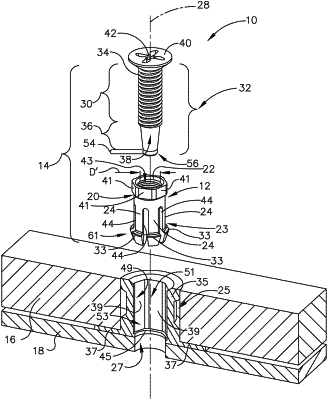| CPC F16B 39/284 (2013.01) [F16B 5/0258 (2013.01); B64F 5/10 (2017.01)] | 21 Claims |

|
1. A fastener assembly, comprising:
a fastener including a head and a shaft extending from the head;
wherein the shaft includes a first portion that presents threads, a second portion that extends from the first portion and tapers inwardly as the second portion extends away from the first portion, and a third portion that extends away from the first portion and the second portion, and wherein the second portion is disposed between the first portion and the third portion;
an e-nut including an inner wall that defines a boundary of a hole, wherein the inner wall of the e-nut presents threads, and the e-nut includes at least one tine;
wherein the threads of the first portion of the shaft and the threads of the e-nut engage each other to attach the fastener and the e-nut together as a sub-assembly in an initial position;
an insert defining an opening extending between a first end and a second end of the insert, and the opening of the insert is configured to receive the sub-assembly in the initial position, wherein the insert includes an internal wall surrounding the opening to define a boundary of the opening, and the insert includes a ledge extending outwardly from the internal wall into the opening of the insert, and a portion of the e-nut abuts the ledge when the sub-assembly is disposed inside of the opening in the initial position; and
wherein the sub-assembly is movable from the initial position to a final position within the insert to attach the sub-assembly to the insert by rotating the fastener relative to the e-nut in which the threads of the first portion of the shaft advance along the threads of the e-nut such that the shaft engages the inner wall of the e-nut which pushes the at least one tine outwardly away from the shaft to the final position.
|